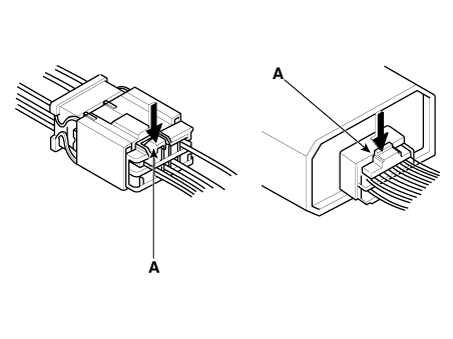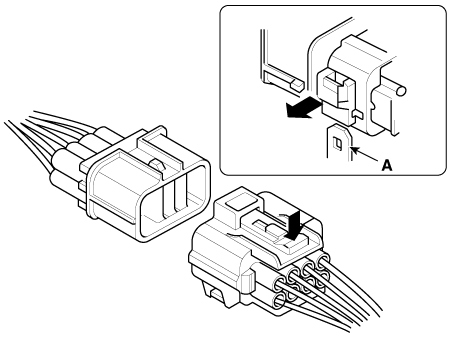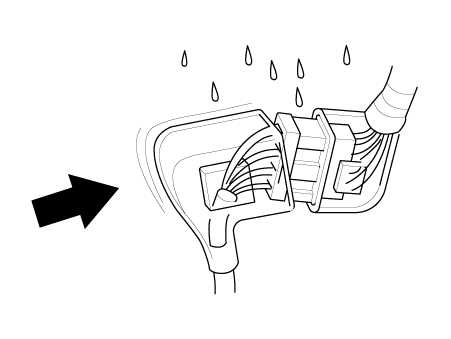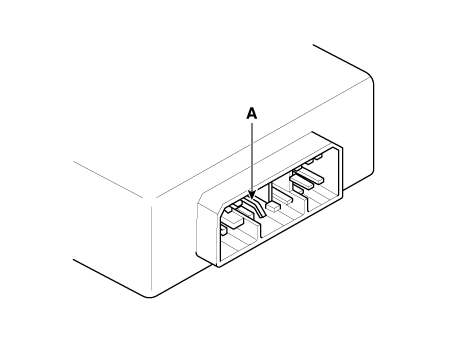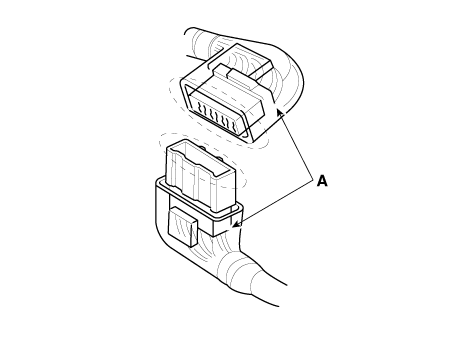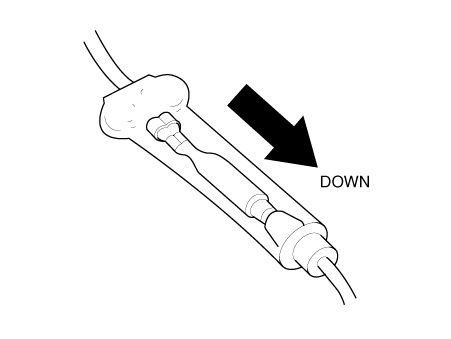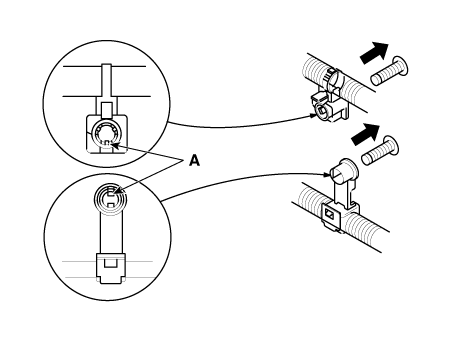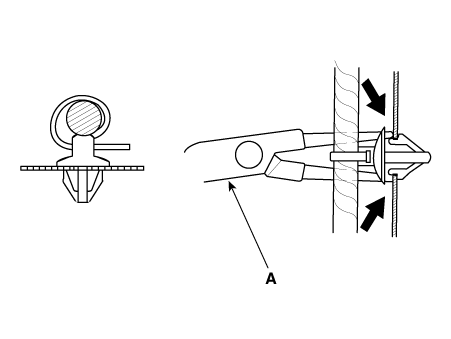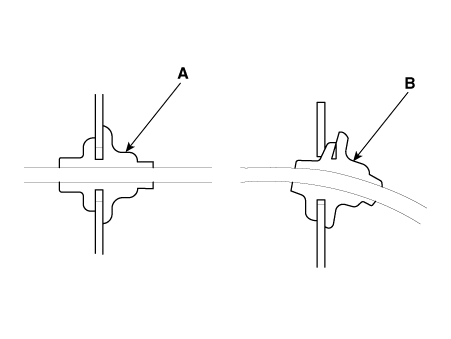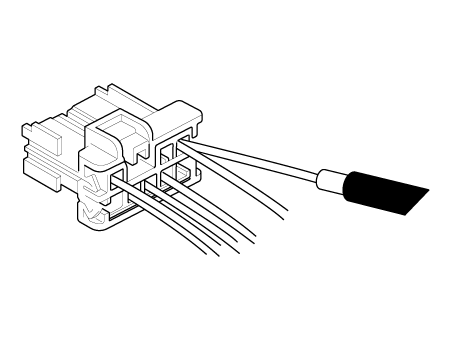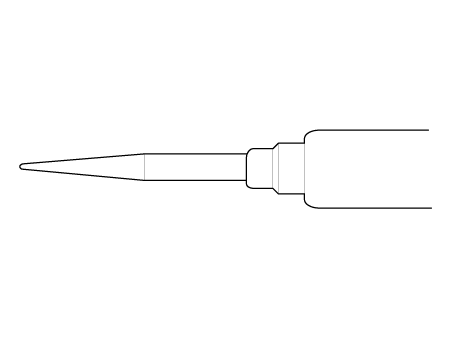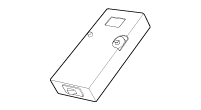Kia Rio: Body Electrical System
General information
| General Troubleshooting Information |
Before Troubleshooting
| 1. |
Check applicable fuses in the appropriate fuse/relay box. |
| 2. |
Check the battery for damage, state of charge, cleanliness and tight connections. D 1.4 U2 TCI (Refer to Engine Electrical System - "Charging System") G 1.0 T-GDI KAPPA (Refer to Engine Electrical System - "Charging System") G 1.2 MPI KAPPA (Refer to Engine Electrical System - "Charging System") G 1.4 MPI KAPPA (Refer to Engine Electrical System - "Charging System")
|
| 3. |
Check the alternator belt tension (D). |
Handling Connectors
| 1. |
Make sure the connectors are clean and have no loose wire terminals. |
| 2. |
Make sure multiple cavity connectors are packed with grease (except watertight connectors). |
| 3. |
All connectors have push-down release type locks (A).
|
| 4. |
Some connectors have a clip on their side used to attach them to a mount bracket on the body or on another component. This clip has a pull type lock. |
| 5. |
Some mounted connectors cannot be disconnected unless you first release the lock and remove the connector from its mounting bracket (A).
|
| 6. |
Never try to disconnect connectors by pulling on their wires; pull on the connector halves instead. |
| 7. |
Always reinstall plastic covers.
|
| 8. |
Before connecting connectors, make sure the terminals (A) are in place and not bent.
|
| 9. |
Check for loose retainer (A) and rubber seals (B).
|
| 10. |
The backs of some connectors are packed with grease. Add grease if necessary. If the grease (A) is contaminated, replace it.
|
| 11. |
Insert the connector all the way and make sure it is securely locked. |
| 12. |
Position wires so that the open end of the cover faces down.
|
Handling Wires And Harnesses
| 1. |
Secure wires and wire harnesses to the frame with their respective wire ties at the designated locations. |
| 2. |
Remove clips carefully; don't damage their locks (A).
|
| 3. |
Slip pliers (A) under the clip base and through the hole at an angle, and then squeeze the expansion tabs to release the clip.
|
| 4. |
After installing harness clips, make sure the harness doesn't interfere with any moving parts. |
| 5. |
Keep wire harnesses away from exhaust pipes and other hot parts, from sharp edges of brackets and holes, and from exposed screws and bolts. |
| 6. |
Seat grommets in their grooves properly (A). Do not leave grommets distorted (B).
|
Testing and Repairing
| 1. |
Do not use wires or harnesses with broken insulation. Replace them or repair them by wrapping the break with electrical tape. |
| 2. |
After installing parts, make sure that no wires are pinched under them. |
| 3. |
When using electrical test equipment, follow the manufacturer's instructions and those described in this manual. |
| 4. |
If possible, insert the remover tool from the wire side (except waterproof connector).
|
| 5. |
Use a probe with a tapered tip. Refer to the user's guide in the wiring repair kit (Pub No. : TRK 015.)
|
Five-step Troubleshooting
| 1. |
Verify the complaint Turn on all the components in the problem circuit to verify the customer complaint. Note the symptoms. Do not begin disassembling or testing until you have narrowed down the problem area. |
| 2. |
Analyze the schematic Look up the schematic for the problem circuit. Determine how the circuit is supposed to work by tracing the current paths from the power feed through the circuit components to ground. If several circuits fail at the same time, the fuse or ground is a likely cause. Based on the symptoms and your understanding of the circuit operation, identify one or more possible causes of the problem. |
| 3. |
Isolate the problem by testing the circuit. Make circuit tests to check the diagnosis you made in step 2. Keep in mind that a logical, simple procedure is the key to efficient troubleshooting. Test for the most likely cause of failure first. Try to make tests at points that are easily accessible. |
| 4. |
Fix the problem Once the specific problem is identified, make the repair. Be sure to use proper tools and safe procedures. |
| 5. |
Make sure the circuit works Turn on all components in the repaired circuit in all modes to make sure you've fixed the entire problem. If the problem was a blown fuse, be sure to test all of the circuits on the fuse. Make sure no new problems turn up and the original problem does not recur. |
Battery Reset
| Description |
When reconnecting the battery cable after disconnecting, recharging battery after discharged or installing the memory fuse located on the driver's side panel after removing, be sure to reset systems mentioned in the below table.
In addition, when replacing or reinstalling their fuses after removing, they should be reset according to the below table. Please refer to the below table when servicing.
|
System |
Resetting |
||||||||||||||
|
Power window |
Whenever the window cannot be properly closed or opened. Whenever the battery
is discharged or the related fuse is replaced or reinstalled, reset the
power window system according to the procedure below.
|
||||||||||||||
|
Sunroof |
Whenever the vehicle battery is disconnected or discharged, or you use the
emergency handle to operate the sunroof, you have to reset your sunroof
system as follows :
|
||||||||||||||
|
Trip computer |
When the battery is disconnected and reconnected, the set functions of the
trip computer become initialized. So, you need to explain this information
to the customer. |
||||||||||||||
|
Clock |
When the battery is disconnected and reconnected, the clock becomes initialized.
So, the clock should be reset. (Refer to the owner's manual) |
||||||||||||||
|
Audio |
When the battery is disconnected and reconnected, the customer's radio stations
become initialized. So, you need to record the customer's radio stations
prior to service, and after service, set the customer's radio stations into
the audio. |
||||||||||||||
|
Heater & Air Conditioner |
When the battery is disconnected and reconnected, the heater and A/Con become
initialized. So, heater and A/Con should be reset. |
Special service tools
| Special Service Tools |
|
Tool Name / Number |
Illustration |
Description |
|
RKE Battery Checker 09954-2P100 |
|
Measuring the RKE battery voltage |
|
Calibration jig for LDWS or LKAS 09890-3V100 |
|
Calibration of LDWS (Lane Departure Warning System) or LKAS (Lane Keeping
Assist System) |
- Audio
- Auto Lighting Control System
- AVN System
- Back View Camera System
- Body Control Module (BCM)
- Button Engine Start System
- Electro Chromic Inside Rear View Mirror
- Fuses And Relays
- Headlamp Leveling System
- Horn
- Ignition Switch
- Immobilizer System
- Indicators And Gauges
- Keyless Entry And Burglar Alarm
- Lane Departure Warning System (LDWS)
- Lighting System
- Headlamps
- Turn Signal Lamp
- Room Lamp
- Vanity Lamp
- Overhead Console Lamp
- Hazard Lamp Switch
- Rheostat
- Front Fog Lamps
- License Lamps
- High Mounted Stop Lamp
- Rear Combination Lamp
- Multifunction Switch
- Power Door Locks
- Power Door Mirrors
- Power Windows
- Rear Glass Defogger
- Rear Wiper/Washer
- Rear Parking Assist System
- Seat Electrical
- Smart Key System
- Sunroof
- Windshield Wiper/Washer
 Windshield Glass
Windshield Glass
Components and components location
Components
1. Windshield glass
2. Windshield glass molding
Repair procedures
Removal
...
 Audio
Audio
Specifications
Specifications
Items
Specifications
Model
Radio/MP3 (A Type)
Radio/MP3/Bluetooth (B Type)
...
Other information:
Kia Rio 2017-2025 YB Service Manual: Brake Booster
Components and components location Components 1. Brake booster assembly 2. Reservoir 3. Master cylinder Repair procedures Brake Booster Operating Test For simple checking of the brake booster operation, carry out the following tes ...
Kia Rio 2017-2025 YB Owners Manual: Good braking practices
Check to be sure the parking brake is not engaged and that the parking brake indicator light is out before driving away. Driving through water may get the brakes wet. They can also get wet when the vehicle is washed. Wet brakes can be dangerous! Your vehicle will not stop as quickly if ...


